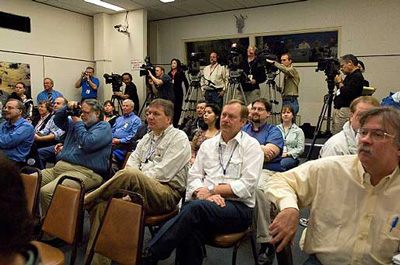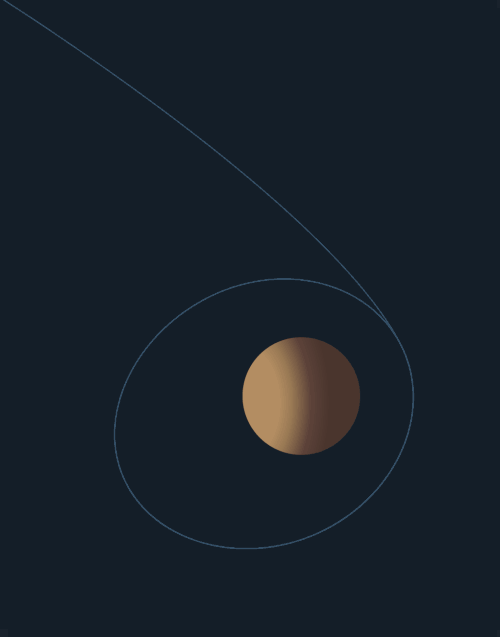Chapter 16: Encounter
Upon completing this chapter, you will be able to describe major factors involved in flyby operations, planetary orbit insertion, planetary system exploration, planet mapping, and gravity field surveying. You will be able to describe the unique opportunities for science data acquisition presented by occultations, and problems involved. You will be able to describe the concepts of using aerobraking to alter orbital geometry or decelerate for atmospheric entry, descent and landing.
The term "encounter" is used in this chapter to indicate the high-priority data-gathering period of operations for which the mission was intended. It may last a few months or weeks or less as in the case of a flyby encounter or atmospheric probe entry, or it may last a number of years as in the case of an orbiter. For JPL missions, brief critical portions of encounter operations are typically carried out from a special room within the Space Flight Operations Facility that is equipped for television cameras and VIP visits.
All the interplanetary navigation and course corrections accomplished during cruise result in placement of the spacecraft at precisely the correct point, and at the correct time to carry out its encounter observations. A flyby spacecraft has a limited opportunity to gather data. Once it has flown by its target, it cannot return to recover any lost data. Its operations are planned years in advance of the encounter, and the plans are refined and practiced in the months prior to the encounter date. Sequences of commands are prepared, tested, and uplinked by the flight team to carry out operations in various phases of the flyby, depending on the spacecraft's distance from its target.
During each of the six Voyager encounters, the phases were called Observatory phase, Far Encounter phase, Near Encounter phase, and Post Encounter phase.
These phases may be given other names on different missions, but many of the functions most likely will be similar. Many of these also apply in some degree to missions other than flyby missions as well. In fact, for a spacecraft orbiting Jupiter or Saturn, for example, flyby encounters occur repeatedly, as the spacecraft approaches each targeted satellite, on orbit after orbit.

In a flyby operation, Observatory phase (OB) begins when the target can be better resolved in the spacecraft's optical instruments than it can from Earth-based instruments. This phase generally begins a few months prior to the date of flyby. OB is marked by the spacecraft being for the first time completely involved in making observations of its target (rather than cruise activities), and ground resources are completely operational in support of the encounter. The start of this phase marks the end of the interplanetary cruise phase. Ground system upgrades and tests have been completed, spacecraft flight software modifications have been implemented and tested, and the encounter command sequences have been placed on board.
Far Encounter phase (FE) begins when the full disc of a planet can no longer fit within the field of view of the instruments. Observations are designed to accommodate parts of the planet rather than the whole disc, and to take best advantage of the higher resolution available.
Near Encounter phase (NE) includes the period of closest approach to the target. It is marked by intensely active observations with all of the spacecraft's science experiments, including onboard instruments and radio science investigations. It includes the opportunity to obtain the highest resolution data about the target. During NE, radio science observations may include ring plane measurements during which ring structure and particle sizes can be determined. Celestial mechanics observations can determine the planet's or satellites' mass, and atmospheric occultations can determine atmospheric structures and compositions.
Late Updates
While observations must be planned in detail many months or years prior to NE, precise navigation data may not be available to command accurate pointing of the instruments until only a few days before the observations execute. So, late updates to stored parameters on the spacecraft can be made to supply the pointing data just in time. OPNAVs, discussed in Chapter 13, may be an important navigational input to the process of determining values for late parameter updates.
Also, some observations of the target planet, or its satellites or environs may be treated as reprogrammable late in the encounter, in order to observe features that had not been seen until FE. Commands to cover new targets might be uplinked, or an entire block of observations may be commanded to shift in time.
During the end of FE or the beginning of NE, a bow shock crossing may be identified through data from the magnetometer, the plasma instrument and plasma wave instrument as the spacecraft flies into a planet's magnetosphere and leaves the solar wind. When the solar wind is in a state of flux, these crossings may occur again and again as the magnetosphere and the solar wind push back and forth over millions of kilometers.
Post encounter phase (PE) begins when NE completes, and the spacecraft is receding from the planet. It is characterized by day after day of observations of a diminishing, thin crescent of the planet just encountered. This is the opportunity to make extensive observations of the night side of the planet. After PE is over, the spacecraft stops observing its target planet, and returns to the activities of cruise phase. DSN resources are relieved of their continuous support of the encounter, and they are generally scheduled to provide less frequent coverage to the mission during PE.
After encounter, instrument calibrations are repeated to be sure that any changes in the instruments' states are accounted for.

The same type of highly precise interplanetary navigation and course correction used for flyby missions also applies during cruise for an orbiter spacecraft. This process places the spacecraft at precisely the correct location at the correct time to enter into planetary orbit. Orbit insertion requires not only precise position and timing, but also controlled deceleration. As the spacecraft's trajectory is bent by the planet's gravity, the command sequence aboard the spacecraft places the spacecraft in the correct attitude, and fires its engine(s) at the proper moment and for the proper duration.
Once the retro-burn has completed, the spacecraft has been captured into orbit by its target planet. If the retro-burn were to fail, the spacecraft would continue to fly on past the planet as though it were a flyby mission. It is common for the retro-burn to occur on the far side of a planet as viewed from Earth, with little or no data available until well after the burn has completed and the spacecraft has emerged from behind the planet, successfully in orbit.
Once inserted into a highly elliptical orbit, Mars Global Surveyor continued to adjust its orbit via aerobraking (discussed later in this chapter) near periapsis to decelerate the spacecraft further, causing a reduction in the apoapsis altitude, and establishing a close circular orbit at Mars.
Mars Odyssey used the same technique. Galileo used a gravity assist from a close flyby of Jupiter's moon Io to decelerate, augmenting the deceleration provided by its 400 N rocket engine. Thereafter, additional Orbit Trim Maneuvers (OTMs) over a span of several years were used to vary the orbit slightly and choreograph multiple encounters with the Galilean satellites and the magnetosphere. Cassini is currently doing the same in orbit at Saturn.
At least two broad categories of orbital science-gathering operations may be identified: system exploration and planetary mapping. Exploring a planetary system includes making observations of the planet, its atmosphere, its satellites, its rings, and its magnetosphere during a tour typically a few years or more in duration, using the spacecraft's complement of remote-sensing and direct-sensing instruments.
On the other hand, mapping a planet means concentrating observations on the planet itself, using the spacecraft's instruments to obtain data mainly from the planet's surface and atmosphere.
Galileo explored the entire Jovian system, including its satellites, rings, magnetosphere, the planet, its atmosphere, and its radiation environment. At Saturn, Cassini is engaged in a similar exploratory mission, examining the planet's atmosphere, rings, magnetosphere, icy satellites, and the large satellite Titan, which has its own atmosphere. Magellan, a planetary mapper, covered more than 99% the surface of Venus in great detail using Synthetic Aperture Radar (SAR) imaging, altimetry, radiometry, gravity field, and mass distribution. A few special experiments were also carried out, including bistatic radar, aerobraking, windmilling, and destructive atmospheric entry. Mars Global Surveyor and Mars Odyssey are mapping the surface of their planet using imaging, altimetry, spectroscopy, and a gravity field survey.
An orbit of low inclination at the target planet (equatorial, for example) is well suited to a system exploration mission, because it provides repeated exposure to satellites orbiting within the equatorial plane, as well as adequate coverage of the planet and its magnetosphere. An orbit of high inclination (polar, for example) is better suited for a mapping mission, since the target planet or body will rotate fully below the spacecraft's orbit, providing eventual exposure to every part of the planet's surface.
In either case, during system exploration or planetary mapping, the orbiting spacecraft is involved in an extended encounter period, requiring continuous or dependably regular support from the flight team members, the DSN, and other institutional teams.





